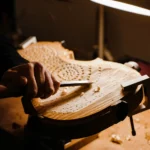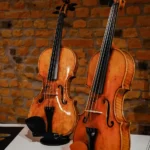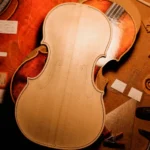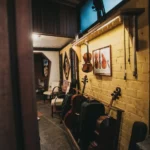Violin Makers in Cremona: History & Present
Back to BlogViolin Makers in Cremona: History & Present
Deep in the heart of Italy, nestled along the tranquil banks of the Po River, lies the charming town of Cremona. This enchanting town has been a sanctuary for centuries for craftsmen, musicians, and dreamers. Cremona is the epicenter of violin making, where the art of crafting violin, viola, and cello has been perfected over generations.
In our blog, ‘Violin Makers in Cremona: History & Present,’ we embark on a journey through time, exploring the rich legacy of Cremona violin makers from the past and delving into the vibrant present. From Stradivari and Guarneri to today’s modern craftsmen, we’ll uncover the enduring legacy of Cremona’s violin-making tradition and witness how it continues to shape the music world today.
Cremona, The Violin Maker’s City
The Italian city of Cremona, located in the northern region of Lombardy, has only 70,000 inhabitants. Still, it is home to more than 150 luthiers of string instruments, primarily violins, violas, and cellos.
It is thus a significant hub for luthiers, the makers of violins and other string instruments. The skills of these important masters and their techniques have been passed down from generation to generation, and thanks to this art, Cremona has been on the UNESCO Intangible Cultural Heritage list since 2012.
Cremona violin makers are renowned for their work, which mixes beauty and quality, with a tradition dating back over 450 years, when the luthier Andrea Amati established the violin standards. Even today, many techniques from that time are still used in Cremonese violins.
For many years, violin making in Cremona went through a period of decline but began to thrive again in 1937 during the celebration of the two-hundredth anniversary of the death of the master violin maker Antonio Stradivari.
A grand spectacle was organized, bringing violins from great masters worldwide and instruments from the 16th and 17th centuries, including pieces by Stradivarius, Niccolò Amati, and Guarneri del Gesù.
The concert was so successful that the following year, the International School of Violin Making in Cremona was established, encouraging young artisans to dedicate themselves to violin making.
Italian luthiers have always stood out as great craftsmen since the 16th century, with three families being the most renowned in the art of constructing violins, violas, and cellos. Andrea Amati initiated violin making in the Cremonese style, producing violins with his sons.
The Guarneri family were also important makers in the city around the 17th and 18th centuries, with their instruments highly sought after by collectors and prominent violinists. Antonio Stradivari was one of the most recognized violin makers, creating true works of art from 1644 to 1737.
Today, the production of violins in Cremona remains active and vital, following the city’s centuries-old tradition. We have talented artisans who excel in the art of lutherie. Check the list of the most known Cremona violin makers.
Cremona Violin Makers: a list
Nicolo Amati:
He was a luthier from a traditional Cremonese family of violin and string instrument makers. Nicolo Amati followed his family’s tradition after many Cremonese makers passed away due to diseases that swept through the region in 1630. His violins had their own style and a distinct sound, along with an attractive design. Great luthiers worked in his workshop, such as Antonio Stradivari, and Andrea Guarneri.
Antonio Stradivari:
Antonio Stradivari was born in Cremona in 1644 and passed away in 1737. He was undoubtedly one of the most famous violin makers. It is estimated that Stradivari may have crafted over a thousand instruments, including violins. His first known violin was made in 1666 when he was only 22 years old.
Today, we know of around 600 violins created by Stradivari, with the most highly valued ones between 1700 and 1720. After studying with Nicolo Amati in 1666, Stradivari began his solo career, and in 1684, he created his own violin models larger than those inspired by his former master. This was a true innovation for the time. He also began using a reddish varnish on his violins, which became his trademark, and the formula for it has never been discovered.
His craftsmanship extended beyond violins; he also crafted wonderful cellos and violas. Thanks to Stradivari, a new standard in violin-making was established. His instruments introduced a new proportion that made the instrument’s sound stronger and more penetrating.
Antonio Stradivari had two sons, Francesco and Omobono, who also made violins.
Andrea Guarneri:
The Guarneri Family was another renowned family from Cremona, Italy, with a violin-making tradition. Andrea Guarneri (1626-1698) worked alongside Antonio Stradivari at Nicolò Amati’s workshop. He is a pivotal figure who deeply imbibed the revered Amati tradition. Andrea’s masterful adoption of Amati’s model resulted in works so exquisitely crafted that they often blur the line between his creations and those of his esteemed mentor. While Andrea’s style exhibits a touch of greater freedom and perhaps slightly less precision than Amati’s, it consistently attains superlative quality.
In addition to his remarkable contributions to the world of violins, Andrea played a pivotal role in establishing the prolific Guarneri dynasty. Collaborating closely with his sons Giuseppe’ filius Andrea’ and Pietro of Mantua, their combined efforts left an indelible mark, especially in his later years. The legacy of Andrea Guarneri laid the foundation for a remarkable lineage of Guarneri violin makers, each contributing to the enduring and towering reputation of the Guarneri name.
Giuseppe Guarneri ‘filius Andreae,’
Often referred to as ‘filius Andreae,’ he was a skilled violin maker who took over his father Andrea’s renowned workshop in 1698, cementing his role within the esteemed Guarneri family lineage of luthiers. Giuseppe’s journey to mastery was marked by years of apprenticeship alongside his father, during which he played a substantial role in crafting many instruments credited to Andrea. His innovation distinguished Giuseppe; he didn’t merely replicate his father’s designs. Instead, he introduced unique elements, infusing his work with originality. Despite his remarkable craftsmanship and significant contributions to violin making, Giuseppe Guarneri I’s recognition was somewhat eclipsed by the contemporary fame of Antonio Stradivari.
Continuing the Guarneri tradition, Giuseppe’s sons, Pietro and Giuseppe’ del Gesù,’ joined him in the workshop around 1710. Pietro embarked on his own path in 1717, establishing himself as a violin maker in Venice. Meanwhile, ‘del Gesù’ remained in Cremona and ultimately inherited the family workshop. His legacy would ascend to extraordinary heights as he became one of the most celebrated and inventive violin makers in the annals of history.
Giuseppe Guarneri del Gesù:
The most famous member of the Guarneri family of violin makers in Cremona, Italy, was Bartolomeo Giuseppe Guarneri (1698-1744), known as Joseph Guarnerius del Gesu. The use of “del Gesu” in Giuseppe’s name, an abbreviation of the Greek for Jesus (IHS), came from its inclusion in the labels placed inside his violins.
In contrast to his brother, ‘del Gesù’ embarked on a remarkable innovation journey, producing instruments renowned for their rich and complex tonal qualities. Although ‘del Gesù’ crafted his earliest independent instruments in the 1720s, it wasn’t until 1731 that he introduced his trademark IHS (Iesus Hominem Salvator) label. His work bore influences from the Brescian school. Guarneri’s violins compete with Stradivari’s for the preference of great violinists, even though Stradivari’s production was much larger, with del Gesu presumed to have made around 250 violins only.
Carlo Bergonzi:
Bergonzi’s craftsmanship is renowned for its exceptional materials, meticulous varnish application, and impeccable execution. Considered a master in his own right, Carlo Bergonzi’s reputation is second only to his contemporaries, Stradivari and Guarneri’ del Gesù.’ His contributions to the world of violin-making continue to be celebrated and revered. Carlo Bergonzi belonged to the Bergonzi family, which had a long tradition of crafting string instruments in Cremona. Carlo Bergonzi supposedly studied in the workshop of Vincenzo Rugeri. His early violins closely resembled those of his master Rugeri, but his instruments later showed a considerable influence from Guarneri del Gesù and Antonio Stradivari. Especially after 1746, when the Bergonzi family resided in the Casa Stradivari. During this period, Carlo Bergonzi devoted his skills to completing instruments left unfinished by Antonio Stradivari.
Lorenzo Storioni:
Lorenzo Storioni, a renowned violin maker, was inspired by the legacy of “Del Gesù” and created his own style with a strong personality. He was considered one of the main keepers of the Cremonese tradition in the late 1700s, alongside G.B. Ceruti and the Bergonzi family. Storioni’s instruments are known for their brilliant and powerful sound.
Lorenzo Storioni is by far one of the most intriguing violin makers in the Cremonese School and one of the most historically significant makers of the Rococò and early classicism period. The most exciting aspect of his life and work is that despite not being linked to any nobility, sponsors, or patrons we know, his career was rather prolific. Not specifically by the number of instruments he made, but considering his relatively short career and the non-favorable times he lived in. Despite the decay of nobility’s wealth and power and the Church’s role as sponsor of culture in the second half of the 18th century, the chaotic political and economic context in Europe with the erupting revolutions and social transformation, he still managed to make a considerable number of instruments, that are very much appreciated for their sound quality, even if the craftsmanship is probably not what is expected from 1700s Cremonese violin making.
Giovanni Battista Ceruti:
Giovanni B. Ceruti lived the last decades of the Cremonese classical period of violin-making history and was mainly responsible for keeping this tradition alive from the 18th to the 19th century by passing the knowledge of the craft to his son, Giuseppe, to be then held for his grandson, Enrico. During the period, after the absence of Lorenzo Storioni in Cremona, the high demand for Cremonese violins was mainly served by Giovanni Ceruti, as there were too few violin makers in town at the time. He might have taken over Storioni’s workshop in 1802 after he left the city towards the east.
Ceruti developed and worked on personal models based on classical Cremonese masterpieces, already considered instruments of the peak of the classical Cremonese tradition golden era. Ceruti had a productive career, and his instruments are recognized by their refined carving, quality varnish, and deep, powerful sound. The maker died in 1817, and his son and grandson were responsible for continuing the family legacy towards the establishment of a modern school of violin-making.









